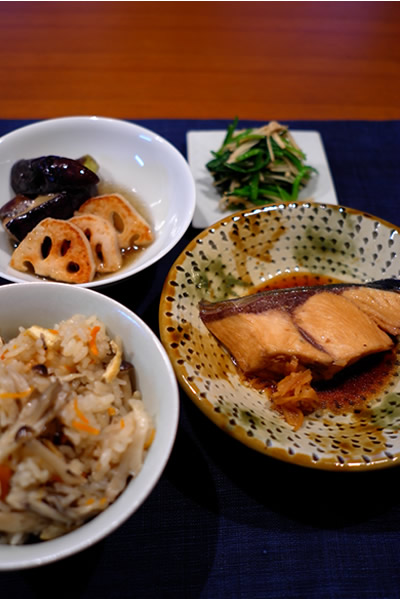CIP Blog 2: The Koto
The first time I ever heard the koto played was in my second year of elementary school and I, child that I was, fell in love with the sound and swore that one day I would learn to play it. To find myself in Japan some thirteen years later, realizing that childhood pledge is a bit wondrous in an odd sort of way. I’m not sure if it was serendipity or extreme care when it came to assigning host families (though I suspect it was the latter) but I was lucky enough to be placed in a homestay with connections that allowed that childhood whim to become a reality.
As with most things, it started off rather simple and increased with difficulty as I progressed to more complex pieces. However, though I’ve learned many songs and practices associated with the ikuda-ryuu tradition, I feel that what I’ve really gained is a glimpse into the heart of Kyoto.
My instructor, Imoto-sensei, is both nothing like I expected she would be, and precisely how I imagined a Japanese thespian would be, if that makes any sense at all. She was raised in an era where everything from behavior to language was cultivated to present a certain image of the Japanese woman, and in Japan’s ancient capital no less. This, combined with her artistic roots and, of course, her own personality has lead her to speak with some of the most flowery language I’ve ever heard. Now, by flowery I don’t mean poetic and overdone, but elegant, pitched, and extremely polite. So polite, in fact, that I was thrown when she spoke to me, her student, in keigo (honorific language), and bowed so many times I eventually lost count.
Naturally, when your sensei bows, you bow back (and lower) and respond to her words in kind. This formality, from what I’ve heard, is not uncommon in the world of traditional Japanese arts, but as one who is still somewhat unsure when to bow to whom and how deeply, I found myself a bit flustered until I learned how to enter, greet, and then conclude these lessons. It wasn’t so much that I couldn’t understand the process or words as that there were so many ordered exchanges and bows it took me a few weeks to remember what order they came in. Then there was the presentation of omiyage, and (more difficult to navigate) the way to accept a return gift graciously. I actually found myself biking home in the rain one day with several cold tofu products balanced on one handlebar and about thirty freshly made kara-age on the other, knowing that my host mother had already been cooking all day for her granddaughter’s birthday).
I even had the chance to get an inside glimpse at the way neighborhood relations work when I helped put one of my friends in contact with sensei (I assumed it would take one or two phone calls; in fact it took close to fifteen and a lot of face redress strategies out of respect for people’s existing relations).
All in all I found my experience informative and rewarding. Though it did tend to get time consuming and complicated at times, I realize looking back that it was then that I learned the most. If there is one thing I regret about my CIP, it was the lack of opportunity to interact with people my own age on a more daily basis. Because the American and Japanese school years don’t line up well and we can’t commit to everyday practices, it’s rather difficult for study abroad students to get involved in most university clubs and circles. Unfortunately, this also decreases our chances of interacting with Japanese students who do not actively seek to participate in international circles or courses. Most host families do not tend to have children around our age and, unless you’re up for weekly rounds of nomi-kai (drinking parties), opportunities to befriend Japanese people of our generation are rather limited. Having elected to study abroad a full year, I had hoped to make lasting friendships, but I’m worried that if I don’t find more ways to get involved next semester I’ll lose my chance.
「Private or Group Lesson (Non-Sports)」カテゴリーアーカイブ
Zhuoxin Miao: Taiko Kamiwakakai
My Community Involvement Project this semester is performing the Taiko with Kitanotenmangu Kamiwakakai. Because our group is affiliated with the Kitanotenmangu, the shrine for the god of knowledge in Japan, we are currently performing at Kitanotenmangu every Saturday evening.
When I was looking for CIP at the beginning of the semester, I wanted to join a circle that was fun, Japanese, and relaxed. Initially the mahjong circle caught my attention, but since it would have most of its activities on the other campus, about an hour away from where I am, I could not pursue that further. Then one of my friends came up with the name of the Taiko performing group; because I actually had played the Taiko once when I was in Kanazawa, I thought it was cool to continue it.
The first day of practice was intense. Because often there were people joining in the Kamiwakakai halfway, and not everyone would necessarily come to every practicing session due to other obligations, different levels of experience and skills were expected. As a result, although I did not know any of the pieces the group was playing at that time, I was asked to practice along with them, rather than letting me have a special training session on the side. It was better that way because by doing exactly what the senior members were doing, I felt that I could get used to my new group more easily.
Even though I do not necessarily know everyone’s name in Kamiwakakai, I really do feel that I am part of the group right now. When one of my friends was absent from a practice, people actually cared and would try to figure out the reason; despite the language barrier, people would try to find topics to talk with me; even people with whom I did not have a chance to talk to helped me when I needed something. The Kamiwakakai is like an extended family, where I feel warm, safe, and happy.
Scott Parks: Kyoto Esperanto Association
For an introductory blog post (in Japanese) about my CIP, click here.
Some of the primary goals of the CIP are to get exposure to Japanese culture, improve Japanese language skills, and be involved in a community of Japanese people outside of the internationally-minded perspective of the KCJS study abroad student context. As a result, I was initially worried about the legitimacy of my CIP, participating in the Kyoto Esperanto Association, due to its seeming lack of adherence to these goals. Speaking Esperanto specifically means I’m not speaking Japanese, and Esperantists from any country tend to be outside the mainstream cultural norms of their country, in this case Japan.
Nonetheless, in actuality I’ve found immense value in my CIP. The Kyoto Esperanto Society is surprisingly active, and they have inspired me to continue my journey with the Esperanto movement. In addition to meeting weekly at the Esperanto Kaikan to study, speak, and talk about Esperanto, I’ve also been taking advantage of unique opportunities that the group has provided me.
This month I traveled to Okayama prefecture for my first Esperanto conference, namely the Twelfth Annual Chugoku & Shikoku Esperanto Congress. There I was able to meet many people, make new friends, and get a taste of what Esperanto looks like on a larger scale. In fact, I was lucky enough to meet the organizer of next year’s International Youth Congress, an international gathering of Esperanto speaking youth that takes place every summer in a different country. Next year’s congress is scheduled to take place in Nara, and my experience in Okayama has motivated me to find a way to attend next year’s congress.
On December 3rd, I will be giving a short speech as part of an event to celebrate the birth of Esperanto’s creator. The event will be from 1:30pm-4:30pm in Ooyamazaki (大山崎町) and is open to the public. My talk will be about how I came to be interested in Esperanto as an American who speaks English, largely considered to already have become an international language. For more information, please view the event flyer (Japanese).
エリカ•ネビル:マンガの教室
「我が輩は漫画家である。」
自分のニーズに合ったマンガの教室を探すために、たくさんスクールを見学して三週間後にやっと「二条美術研究所」という教室を見つけました。
「二条美術研究所」は二条城の近くにあって、二条城前駅から歩いて五分しかかかりません。場所は便利ですが、あまり安くありません。入学金が20000円する上に、週に1回の場合は毎月月謝が17000円です。教室は先生のご自宅で行われています。親切なご夫婦がマンガとかデッサンなど、あらゆる絵の描き方を教えてくださいます。先生は子供や大人で、五人ぐらいいます。珍しい教室だと思います。
月曜日と木曜日以外の曜日に教室があります。火曜日と水曜日と金曜日は18:00から21:00までで、土曜日と日曜日は10:00から13:00までと14:00から17:00まで。普通、水曜日の18:00に行っていますが、何曜日に行ってもいいです。
毎回クラスで先生が私に新しい課題を出してくださいます。例えば、第1回目のクラスの時は男の人と女の人のキャラクターを描きました。その前はそのキャラクターの六つの表情を描きました。楽しいです!
キーリー・ナカモト:バレーボールと料理教室
キーリー ナカモト:バレーボールと料理教室
CIPの活動として私はバレーボールと料理をしています。料理のレッスンには行っていませんが、バレーボールの練習はもう一回ありました。このCIPはとても楽しいし、いい運動になるし、おもしろい日本語の練習にもなります。この同志社大学のサークルのバレーボールチームの名前はSunny Bitsで、五十人ぐらい参加しています。初めの練習の時、自己紹介の後で三時間バレーボールのゲームをしました。その後で Sunny Bitsのメンバーと夕食を食べました。バレーボールは共通語のようなものですから、このけいけんは楽しかったです。
私のもう一つのCIPの活動は料理のレッスンです。毎月一回One Dish, One Meal A Dayというクラブは三時間集まって、一緒においしい食べ物を作ります。たいてい、でんとう的な日本の物を作りますが、時々アメリカ料理とイタリアも作ります。十月のメニューはてり焼き、ごはんときのこ、ほうれんそう、なすとれんこんフライでした。おいしそうでしょ?メニューはきせつによって違います。料理サークレでの活動を本当に楽しみにしています。
ズオシン・ミャオ:和太鼓
私がしているCIPは北野天満宮である太鼓会です。金沢で20分間和太鼓を体験したことがあり、かっこいい活動だと思いましたから、参加しました。そして、家から近く、自転車で4分しかかかりません。二週間に1回か2回の練習があり、時々皆が集まって楽しむ懇親会もあります。
和太鼓は、見るだけだと易しい気がしますが、やってこそ太鼓を叩くことの難しさが分かります。まず、基本的にリズムを覚えなければいけないです。曲が多いから、記憶しにくいと思います。リズムを覚えたら、さらに叩く時の使う力も大切です。あるところでは軽く叩いたり、特別なところでは強く叩かなければならないです。まして、音のリズムと強弱の上に、演奏する時の動作も注意しなければいけないです。曲により、「めちゃめちゃ」と声を出したり、腕を回したり、体を揺らしたりします。これらを全部覚え、上手くできてこそ、入門したといえるでしょう。
太鼓のすばらしさはチームワークにあります。上手く叩ける人でも、一人で太鼓の気勢は表現し切れないと思います。太鼓をしながら、自分と近くの人々の叩いた音に巻き込まれ、衝撃を受けながら、感動します。太鼓の簡単な音が心にある悩みなどを打ち消し、単純な太鼓の音に多様なリズムと強弱が加わることで演奏者の個性も出るので、太鼓はものすごくいいものだと思います。
太鼓会のメンバーは色々な経歴を持つ人です。小学校の子供から白髪のおじさんまで活躍します。この間話した女の人は若者ながら、今まで四年間も太鼓会を続けています。日本人はどうしてこんなに伝統的文化に関心を持っているのでしょう。というか、なぜ日本の伝統的文化は生命力が強く、現代社会の文化衝撃を受けながらも、生きていくことができますか。未だに答えが分からないけれども、これから太鼓を叩き続けていけば、分かるようになるかもしれないです。
カアハアイナ・ホク:お琴
最初CIPのために剣道をしたかったけど、その場合はちょっと面倒すぎると思いました。昨同志社の剣道部と京大の剣道部もけいこは土曜日の午後のだし、他の日に遠い京田辺キャンパスへ行ったりしたくなかったです。とにかく、岡山にいる間に、ホストファミリーのお母さんがおことのひき方を教えてくださいました。その後で、剣道からおことにCIPを変えたかったです。最初はおことのけいこは高すぎて、家に動物がいるから楽器を借りないので、おことをひくのは無理と思いました。
でもEクラスのガブリさんはおことのけいこをもう始まったし、山科も住んでいるし、私におことの先生の連絡先をくれました。だから十月の十日に先生に電話しました。次の日に二時間のけいこをしました。優しい歌をひきながら歌いました。でもひくより先生と話すの方が難しかったです。井元先生は話すのが早すぎて、分からない言葉をたくさん使われました。話が全然分かりません。同じの週の木曜日もけいこがありましたが、その時ガブリさんもいました。中学校と高校の時にオーケストラとビオラをひていたので、一人より他の人とひく方が好きです。だからガブリさんとひくのは楽しかったです。ガブリさんに井元先生の話を翻訳してくれました。本当に助かりました。日曜日に祭りがあったから先生の他の生徒と山科にある神社でおことをひきました。神社はとても楽な感じがあって、心配しないでひけました。自分で「チューリップ」と「たなばた」をひきながら歌って「十五夜お月さん」もひいて、ガブリさんと「数え歌」をひいて、「さくらさくら」をひきながら歌いました。たくさん間違えたけど、いい経験でした。
ライネキ・ガブリエル:お琴
私は一ヶ月位前に、井元先生の元でお琴を習い始めました。お琴には生田流と山田流の二つの主な筝曲の流儀がありますが、井元先生が教えて下さっているのは生田流です。
お琴を弾く時、親指(1)・人差し指(2)・中指(3) の三つの指に「爪」と言うギター・ピックのような物をはめて、糸を爪弾きます。二つの流儀の第一違いはこの爪の形なのです。私が習っている生田流では、爪が四角い爪で、山田流のは丸い爪です。もう一つの違いは、山田流では、お琴に対して真っ直ぐに座って弾くものの、生田流では斜めに座るのです。
お琴には十三の糸があるのですが、自分から一番遠い絃から順番に一から十三まで数えます。けれども、お琴の楽譜は音符の代わりに漢字の数字で書いてあるため、二つの字を使う「十一」「十二」「十三」の糸は別名で呼ばれるようになりました。十一本の糸は「斗(ト)」と呼んで、十二本のは「為(イ)」で、十三本のは「巾(キン)」となっています。
お琴は千六百年以前からの日本の伝統楽器で、とても綺麗な音を出しますから、皆さん、是非聞いてみてください!
ナタニエル・スラトー:和太鼓とパルクール
来日にあたって、日本の文化か伝統に関して新しいことが学べる活動をCIPとしようと決めた。来てからすぐ、先生のおかげで北野天満宮の和太鼓グループの責任ŽÒの野々口さんに連絡できて、KCJSの他の二人と一緒にそのグループに参加し始めた。今まで太鼓練習会一回と交流会一回しか行‚¯なかったが、その経験で、そのグループと太鼓の練習が大分好きになった。本当に様々な人が和太鼓を叩く。子供も親も学生も働いている人もいるので、練習会はとてもにぎやかで雰囲気がいい。北野天満宮の太鼓グループは一週間に一回北野天満宮で集まるはずだそうだけれど、今まではそうではない。後でもっと定期的になるといい思う。
北野天満宮の太鼓グループ二週間に一回僕が好きなパルクールというスポーツもしている。まず気づいたのは、無料でスポーツができる所が京都で見つけにくいことだ。加えて、はめずらしくて日本では社会的に大丈夫かなと、最初はちょっとた。しかし、関西地方のNagareParkourというチームを見つけ9月から一緒にパルクールをしている。NagareParkourは二週間に一回大きな「ジャム」という練習会をしている。その練習会には色々なレベルのパルクールが好きな人が集まる上に、初心者のために小さいクラスもある。大阪城公園や京都西京極公園に行ってパルクールをした。
たったの6週間の間に、たくさんの体験ができて、二つの楽しくて優しいグループを見つけることができて本当にうれしい。アメリカに帰るまでこの傾向が続くといいと思う。
スコット・パークス:京都エスペラント会

京都エスペラント会館
エスペラントという言語を知っていますか。いわゆる人工国際補助語ですけれども、簡単に言うと、国際的なコミュニケーションのために人間によって作成された言語です。もっと詳しく知りたい方はこちらをクリックして下さい。
僕はCIPとして、京都エスペラント会というグループに参加しています。京都エスペラント会とは、エスペラントを勉強したり話したりするために存在する会なんです。月曜日、お喋りが中心の集まりがありますが、水曜のお昼と晩は授業もあります。つまり、全部で3つの集まりがあるのですが、僕はエスペラントの初心者だし、暇な時間が限られているし、水曜の昼の授業にしか行っていません。もしエスペラント能力が上達すれば、暇が許す限り、月曜日のお喋りを中心にした会議にも行こうと思っています。
京都エスペラント会の集まりはエスペラント会館というビルであります。そのビルの詳細はここです。僕以外に、参加者はだいたいお年寄りで、僕みたいな若者は他にいないのですが、これは京都エスペラント会だけではなく、世界中のエスペラント会も同じような状況らしいです。従って、エスペラントの将来を僕は心配しています。
僕は京都エスペラント会のブログの最近のポストに出ているので、見てみたい方はこちらをクリックして下さい。



